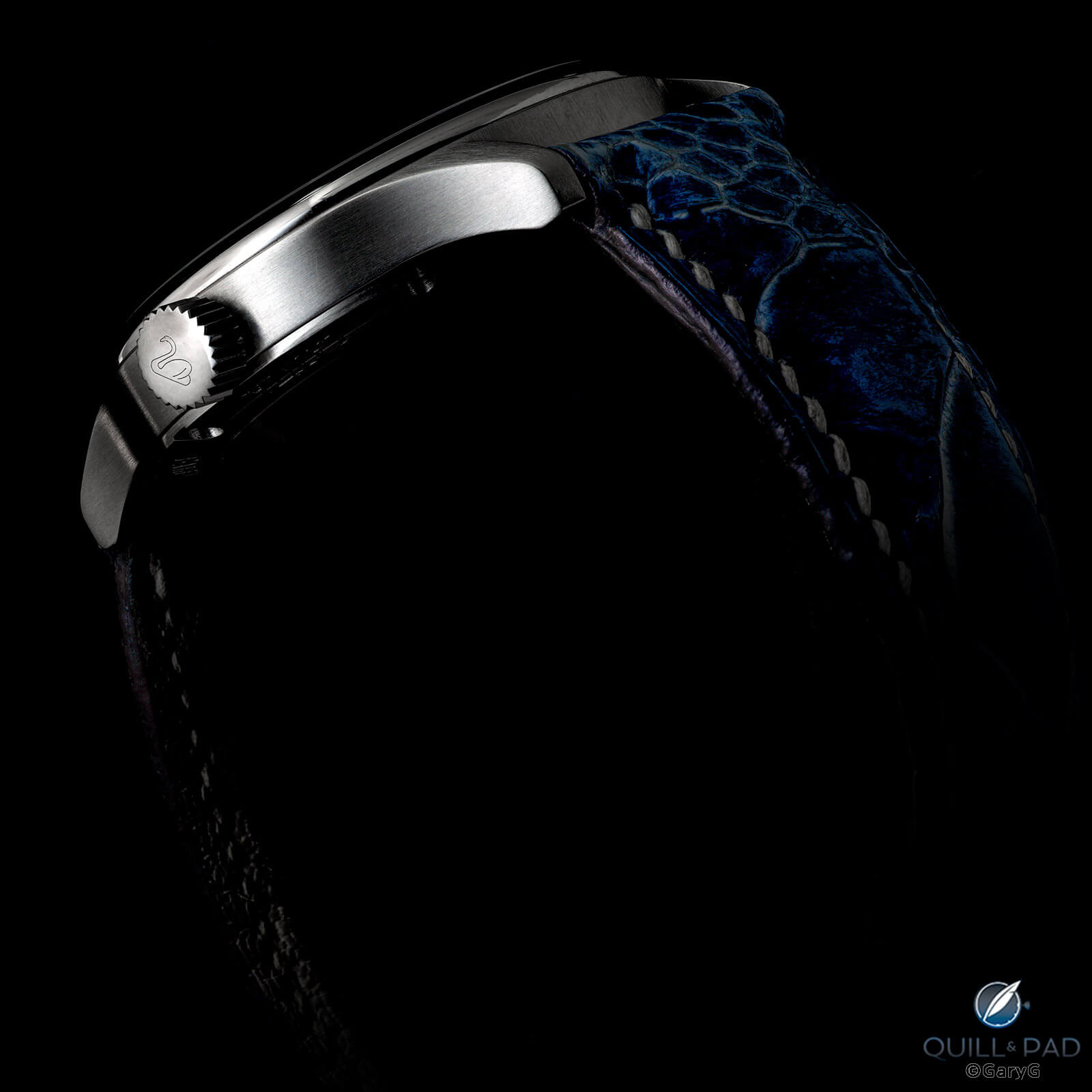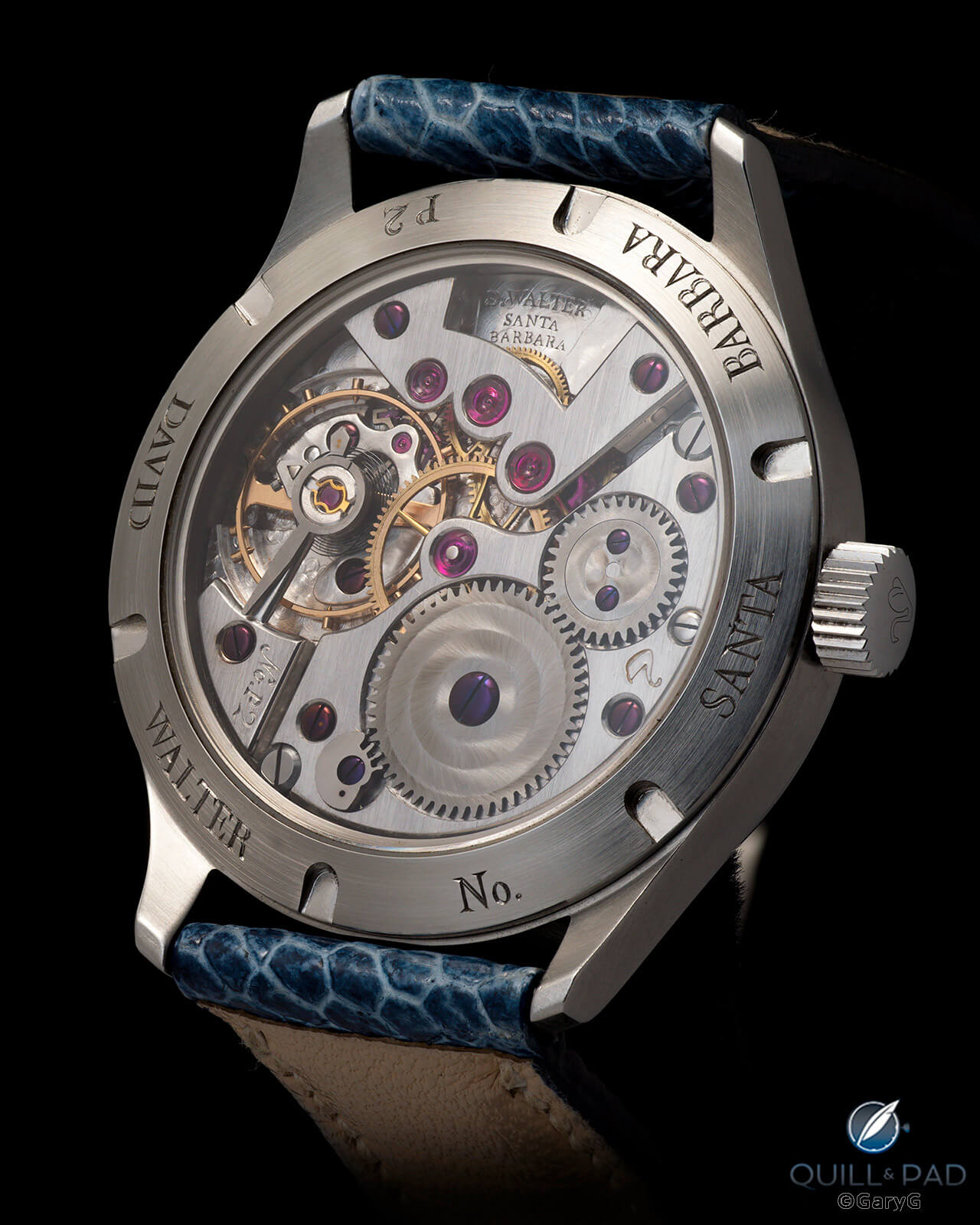by GaryG
In 2019 I had the great pleasure of visiting Australian-turned-American horological wizard David Walter in his California atelier to learn more about him and see one of his remarkable clocks – DeeDee’s Tourbillon – nearing completion.
I had been at least somewhat aware that in addition to being one of the world’s great clockmakers, Walter had turned to creating watches in small series, so I was very interested when he showed me his work in progress on “The White,” a reference based on a modified and hand-finished Omega ébauche.
As described in my earlier article, he had first intended to become a watchmaker; but as a non-European, the difficulty of sourcing high-quality watchmaking tools led him into his work in clockmaking – much to our benefit as an enthusiast community but leaving an itch for watchmaking that he was now returning to scratch.
Fast-forward two-plus years and a welcome opportunity to handle and photograph a unique version of The White, equipped with Walter’s second prototype movement and a bespoke Chinese-character dial, which is owned by a good friend who also happens to be our local expert watchmaker.

The White by David Walter, a unique wristwatch with Chinese character dial
What a lovely piece! My immediate instinct was to strap it onto my wrist; the term “inviting” comes to mind as it is neither too big nor too small, nor too formal or sporty for my tastes.
A special dial
In many ways the dial is the star of the show: a multilayer construction with a prominent circular-brushed annular ring and four separate guilloche patterns.

It’s all about the dial: The White by David Walter
There’s the circular barleycorn around the outer edge of the dial, the deeply notched ring between the minute dots and hour indices, clous de Paris on the minutes subdial, and a classy basket weave on the central dial.
If all that guilloche looks familiar to you, there’s a reason: one of the collaborators on this watch is rapidly emerging watchmaker and noted guilloche artist Joshua Shapiro, another of our California horological stars.

Collaboration number one: dial with guilloche by Joshua Shapiro
The collaboration for the Chinese characters was at the same time more distant and similarly close to home. A Shanghai calligrapher drew the numerals in a traditional style, which were transferred to the metal by another Californian: watchmaker, jeweler, and engraver Artur Akmaev of Los Angeles.

Collaboration number two: engraving by Artur Akmaev on The White by David Walter
It seems these days that no detail is too small to be the cause of controversy, and so I guess I shouldn’t really have been so surprised when upon posting a photo of The White on my Instagram page, I received a comment saying, “As a Chinese I can responsibly tell you that the characters look awful.”
Even though the comment came from an obvious troll account (functional definition: a “private” account with zero posts and zero followers), I was intrigued enough to follow up with some Chinese-speaking friends, who put the comment down to the ongoing efforts of the mainland Chinese government to promote a simplified character set and discourage the more traditional characters used in Taiwan.
One of my friends described the characters on The White as “stylized, but completely recognizable,” which I would expect given that they were penned by an artist. For comparison, here’s a table of traditional numerals as seen on Chinese stamps from the 1930s and 1940s: to my untrained eye the match to Akmaev’s engraved characters seems quite solid, with the latter having a lovely fluidity.

Table of traditional Chinese numerals (photo courtesy stampcommunity.org)
After that brief detour into geopolitics, let’s get back to the watch! Given the amount of handcraft involved with the dial, I think it’s only fitting that the hands are obviously hand-done as well, with vanishingly slender shafts leading to prominent triangular ends that leave no mistake as to the time, even with the briefest glance.

Dial of unique The White by David Walter with blued hands
There are touches of purple in the bluing of the hands, which I for one quite like as a sign of traditional craft, although I understand that some might prefer a more “perfect” look.
The approachable handcraft theme is further reflected in the case, with its slightly softened lug profile and preponderance of scratch-hiding brushed surfaces, and in the steel crown handmade by Walter and engraved with a swan by Akmaev.

Approachable handwork: case profile and engraved bespoke crown, The White
What’s in a name?
Before we flip the watch over, let’s talk about its name. Walter’s naming convention leans on the use of colors and metals (The Platinum, The White, and an upcoming piece based on another color), but when I saw the designator for this watch it was too tempting not to suggest that it be referred to as the “Walter White,” in line with the wry sense of humor of its creator and as a tip of the (porkpie) hat to the television character from Breaking Bad.

Your faithful correspondent doing his best Walter White impression
The response from Walter: “I did think to name it the Walter White. Then I thought how much more fun it would be to have others in the community join in with ‘creative comments,’ and it worked!”
Henceforth, then, let’s call this one the Walter White; a bit of fun, and even more so knowing that it’s what Walter intended from the start.
The movement: more approachable handcraft
When I visited with Walter in 2019, he showed me a partially cased-up version of the first prototype movement for the Walter White, as well as a second movement in process.

Origin story: the first prototype Walter White movement, 2019
As seen today, the second prototype movement is a full step forward, and I’ll be interested to see how the final production series movements compare.

Jumping ahead: Prototype No. 2 movement, Walter White
In Walter’s own words, “The White is based on the fabulous Omega 266, which is an extremely well-engineered and well-made movement; in the 1950’s and ’60’s everyone was trying to make a movement like it, few succeeded. I extensively modified the movement and train, made a new three-pointed click, finished the winding wheels with my ‘butterfly snailing’ finish, made new screws with domed tops and polished and ‘blued’ them to purple rather than blue. This is not easy as blue has numerous hues while purple has only a few shades. After polishing, spotting the plates, and straight graining I rhodium plated the movement.”

Modified and hand-finished movement, Walter White by David Walter
All the points that Walter mentions are evident in the movement photos above, along with other attractive features. I particularly like the ultra-large jewels whose color complements the purple screws, and the beveled interior angles and tourbillon-style balance cock, notably lengthened from the one in the No. 1 prototype, are very much to my taste as well. There’s also the addition of the maker’s name, movement serial number, and logo swan in hand-engraving by Akmaev.
The finishing work is quite clearly by hand, and in some spots lacks the finishing regularity of substantially more expensive pieces from Rexhep Rexhepi and others. To be clear, though, that sort of wringing out the final possibilities of finishing is not what Walter is after with this watch. As he wrote to me: “I perfectly well know the finishing is not equal to Kari [Voutilainen] and it was not intended to be.”

Movement detail, Walter White prototype by David Walter with Artur Akmaev engraving
The Walter White on the wrist
When I finally finished my light tent shooting and strapped the watch onto my wrist, the Walter White lived up to my initial instincts: it’s absolutely wearable while making you happy each time you pull up your sleeve to take a look. The mix of high-art dial and white metal steel case seems just right to make this a potential daily wearer in the same way that my Asaoka Tsunami fits that bill.

On the wrist: unique Walter White by David Walter with Joshua Shapiro and Artur Akmaev
While the Chinese characters at first grab your attention, in subsequent viewings they seem to be completely right; I think that Akmaev and Walter have done a splendid job of selecting the proper proportions for the numerals to keep the dial in perfect balance. Having seen photos of this watch with Roman and Arabic numerals, I’ll confess that I like this treatment at least as well.

Edge view, Walter White unique piece
When the watch is seen from the edge, the lugs curve downward just enough to provide an unbroken line to the shape of the strap, at least on my wrist.
Final thoughts
One of the things I find most interesting about this piece is that it is a true watchmaker’s watch: commissioned by someone who is not only an enthusiast but an accomplished watchmaker on her own merits. Clearly, she values the handmade touches that the three makers have bestowed on this piece, as do I.

Low angle view, Walter White bespoke wristwatch
For me, the collaboration between three notable California artists to create this watch makes it even more special, as it takes a very traditional Swiss model of collaboration among specialists and translates it into the modern world of West Coast technology and business partnerships.

Collaborative success: Walter White by David Walter, Artur Akmaev, and Joshua Shapiro
Is it right for you?
As patronage pieces go, this is in my estimation an entirely worthy one, especially for (but not limited to) Americans interested in advancing the horological arts on our shores. But should you consider adding a Walter White to your collection? I’d suggest yes if:
- The quality of the handcrafted elements of this watch speaks to you, as does the possibility for some customization.
- You are a collector of independent pieces, and the combination of aesthetics, robustness, and wearability of this watch fills a gap in your assortment.
- You like the idea of a handmade watch based on a classic, proven historical movement.
On the other hand, you might want to hold off if:
- You are saving up for one of David Walter’s mouth-watering clocks and can’t have both.
- You both appreciate and are willing to pay for the glowing hand-finishing on offer from Kari Voutilainen and a few other small-volume independents and will accept nothing less.

Parting shot: dial detail, Walter White by David Walter
Let me know your thoughts in the comments below. In the meantime, happy hunting!
To contact David Walter: [email protected]
For more on Joshua Shapiro: www.jnshapirowatches.com
For more on Artur Akmaev: www.arturakmaev.com
Quick Facts “Walter White” by David Walter with Joshua Shapiro and Artur Akmaev
Case: 39 x 10 mm, stainless steel with polished front bezel and brushed lugs, case band, and rear bezel; front and rear sapphire crystals
Dial and hands: silver dial with hand-guilloche by Joshua Shapiro and engraved calligraphic Chinese characters by Artur Akmaev; hand-filed and blued-steel hands by David Walter
Movement: manually wound movement based on Omega Caliber 266, substantially modified and hand-finished; 45-hour power reserve; 18,000 vph/2.5 Hz frequency
Functions: hours, minutes, seconds
Price: $26,750
Limitation: 38 pieces
Production years: 2020 onward
You may also enjoy:
Discovering The Secret Of Life With David Walter: Watches, Clocks, And DeeDee’s Tourbillon
J.N. Shapiro Infinity Tantalum: Fractals, Infinity, And Mastery Of Technique
Leave a Reply
Want to join the discussion?Feel free to contribute!





















































I am not sure those who commented on the chinese character actually practice calligraphy.
1, simplified and the complex form of chinese character: if you are well educated in the language, you can easily read either.
2. one should not call the character on THE WHITE as “stylized”. there are different ways to write chinese calligraphy and the character used on THE WHITE is a known and common form. nothing, it’s not “stylized” per se.
beautiful dial indeed.